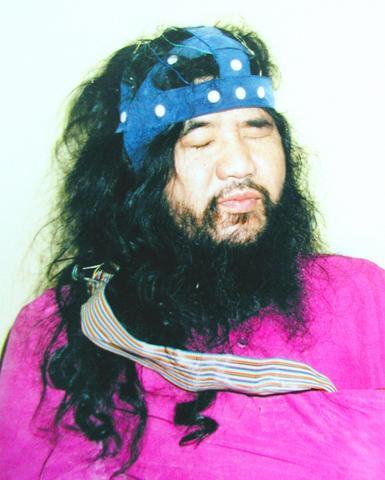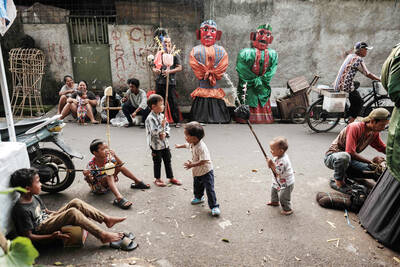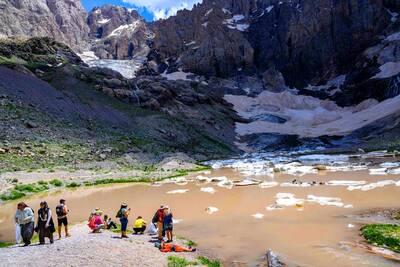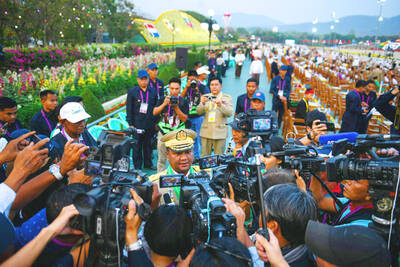A pudgy, nearly-blind yoga teacher who claimed he could levitate and predicted nuclear Armageddon, former Japanese cult leader Shoko Asahara mesmerised thousands of followers before he was arrested eight years ago and charged with ordering a deadly gas attack on the Tokyo subway.
Now Asahara stands as a symbol of evil for a Japanese public shocked to its core by the 1995 sarin nerve gas attack, which shattered Japan's image as a citadel of safety.

PHOTO: REUTERS
Today, a Tokyo court is set to hand down a verdict in a long-running trial in which Asahara, 48, faces the death sentence for masterminding the attack on the rush hour subway that killed 12 people and made more than 5,500 ill.
The son of a poor "tatami" maker and one of seven siblings, Asahara -- whose real name is Chizuo Matsumoto -- graduated from a school for the blind, where he was described by some as ambitious and by others as a bully.
Years later, as the pajama-clad, bearded leader of a cult with 10,000 members in Japan and others in Russia and elsewhere, Asahara rode in a white Rolls Royce and was served by followers catering to his every need.
The cult combined supernatural forecasts of a coming apocalypse -- it predicted the US would attack Japan and turn it into a nuclear wasteland -- with a frightening ability to produce high-tech modes of mass destruction.
Asahara's first job was as an acupuncturist and in the early 1980s he sold traditional Chinese medicine, reportedly amassing wealth by sales of potions like tangerine peel in alcohol.
Next he studied yoga and started a school to teach it. Then, according to cult literature, he travelled to the Himalayas to study Hinduism and Buddhism and meet the Dalai Lama.
In 1987, Asahara registered his Aum Shinrikyo (Supreme Truth Sect), which was attracting some of the brightest science students from elite universities, as an official religious organization.
Three years later, Asahara and a score of his followers ran for parliament but the cult guru won only a smattering of votes.
Doubts about Aum deepened as some parents insisted their children were its prisoners and an anti-sect lawyer, Tsutsumi Sakamoto, disappeared with his wife and baby.
Asahara was said to have commanded absolute loyalty among his followers, who were forced to submit to the strict rules of an ascetic communal life, including a gruelling initiation ceremony and meditation for days in solitary confinement.
Cult members studied Asahara's works and performed rites such as swallowing water and then vomiting it up to "purify" their bodies, and drinking his bathwater to aid enlightenment.
Raids on Aum's sprawling complexes at the foot of Mount Fuji after the subway attack found the cult had amassed stockpiles of high-tech equipment and dangerous chemicals such as sarin.
Asahara, who is also accused of being behind a sarin attack in central Japan that killed seven people in 1994 as well as ordering the murder of lawyer Sakamoto and his family in 1989 and being responsible for the deaths of several cult members, has never testified.
No one knows for sure why the attacks were carried out.
He refused to enter a plea until telling the court he was innocent a year after the trial began and has since only made confusing, unintelligible remarks in the courtroom, including babbling English words.

In the sweltering streets of Jakarta, buskers carry towering, hollow puppets and pass around a bucket for donations. Now, they fear becoming outlaws. City authorities said they would crack down on use of the sacred ondel-ondel puppets, which can stand as tall as a truck, and they are drafting legislation to remove what they view as a street nuisance. Performances featuring the puppets — originally used by Jakarta’s Betawi people to ward off evil spirits — would be allowed only at set events. The ban could leave many ondel-ondel buskers in Jakarta jobless. “I am confused and anxious. I fear getting raided or even

Kemal Ozdemir looked up at the bare peaks of Mount Cilo in Turkey’s Kurdish majority southeast. “There were glaciers 10 years ago,” he recalled under a cloudless sky. A mountain guide for 15 years, Ozdemir then turned toward the torrent carrying dozens of blocks of ice below a slope covered with grass and rocks — a sign of glacier loss being exacerbated by global warming. “You can see that there are quite a few pieces of glacier in the water right now ... the reason why the waterfalls flow lushly actually shows us how fast the ice is melting,” he said.

RISING RACISM: A Japanese group called on China to assure safety in the country, while the Chinese embassy in Tokyo urged action against a ‘surge in xenophobia’ A Japanese woman living in China was attacked and injured by a man in a subway station in Suzhou, China, Japanese media said, hours after two Chinese men were seriously injured in violence in Tokyo. The attacks on Thursday raised concern about xenophobic sentiment in China and Japan that have been blamed for assaults in both countries. It was the third attack involving Japanese living in China since last year. In the two previous cases in China, Chinese authorities have insisted they were isolated incidents. Japanese broadcaster NHK did not identify the woman injured in Suzhou by name, but, citing the Japanese

RESTRUCTURE: Myanmar’s military has ended emergency rule and announced plans for elections in December, but critics said the move aims to entrench junta control Myanmar’s military government announced on Thursday that it was ending the state of emergency declared after it seized power in 2021 and would restructure administrative bodies to prepare for the new election at the end of the year. However, the polls planned for an unspecified date in December face serious obstacles, including a civil war raging over most of the country and pledges by opponents of the military rule to derail the election because they believe it can be neither free nor fair. Under the restructuring, Myanmar’s junta chief Min Aung Hlaing is giving up two posts, but would stay at the